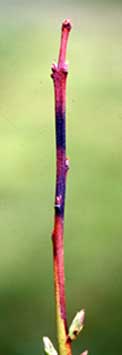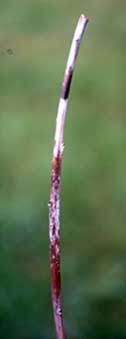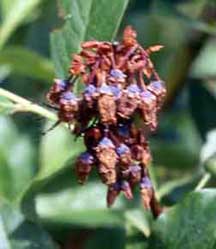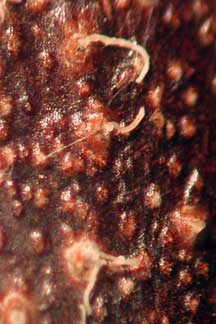Be on the lookout for Phomopsis twig blight in blueberries
Editor’s note: This article is from the archives of the MSU Crop Advisory Team Alerts. Check the label of any pesticide referenced to ensure your use is included.
Phomopsis twig blight is caused by the fungus Phomopsis vaccinii. This disease occurs in most blueberry-growing regions and is present at low levels in most fields. In some years and locations, twig blight can be severe, with over 100 blighted twigs per bush. The reasons for the outbreaks are not clear, but appear to be correlated with frequent or prolonged rains or irrigation events during bloom. Cultivars Jersey and Berkeley are particularly susceptible to Phomopsis twig blight. Bluecrop appears more susceptible to Phomopsis infection of newly developing canes.
Symptoms of twig blight include dark brown lesions and death of young twigs (Figure 1, 2) and collapse of flower and fruit clusters on diseased twigs (Figure 3). The lesions may extend up to several inches from the tip of the twig and there may be more than one lesion per twig. The lesions initially grow fairly rapidly (up to an inch per week), then eventually stop expanding. In some cases, lesions can be seen surrounding dead buds (Figure 4). These buds may have been infected the previous summer or fall. In the spring, the fungus colonizes and kills the infected bud and then grows into the stem tissues. Phomopsis twig blight may be difficult to distinguish from other diseases that can kill flower clusters, such as mummy berry, Botrytis, and anthracnose. The presence of a spreading dark brown lesion is indicative of Phomopsis, but may also be anthracnose. If in doubt, apply a fungicide that is effective against anthracnose as well as Phomopsis.


(Left) Figure 1. Blueberry twig with phomopsis twig blight symptoms. Photo Credit: Phillip Wharton, MSU. (Right) Figure 2. Phomopsis twig blight lesions on vegetative twig.


(Left) Figure 3. Flower cluster killed by phomopsis twig blight (note necrotic stem below cluster). (Right) Lesions developing from infected bud, causing its death.
Phomopsis vaccinii overwinters in dead twigs and canes infected during the previous year(s). Fungal fruiting bodies may be seen with the naked eye with a hand lens in bleached areas as small pimples on the surface of the bark. Once the weather warms in the spring and the twigs are sufficiently wetted by rain or irrigation water, spores are released from these fruiting bodies and are dispersed by rain and irrigation water. The majority of Phomopsis spores are released between bud break and bloom and infect young twigs and the tips of young green canes as they develop. Young, succulent tissues are most susceptible to infection. Older canes may be infected through wounds.



 Print
Print Email
Email


